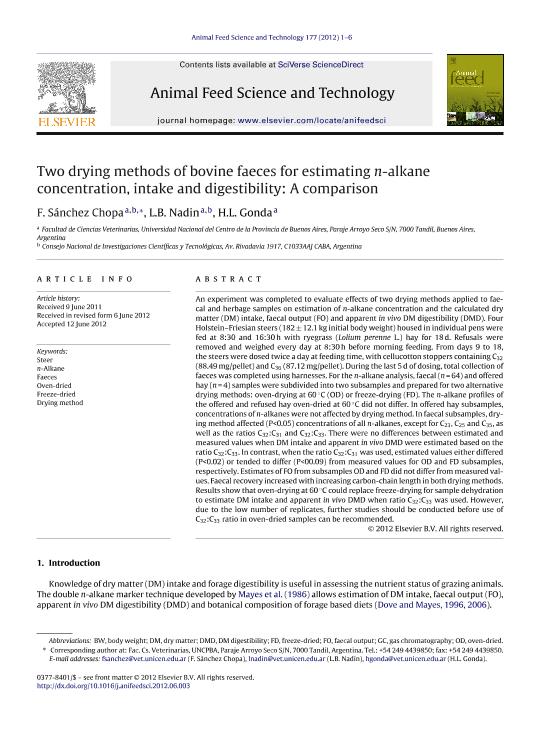Artículo
Two drying methods of bovine faeces for estimating n-alkane concentration, intake and digestibility: A comparison
Fecha de publicación:
01/2012
Editorial:
Elsevier Science
Revista:
Animal Feed Science and Technology
ISSN:
0377-8401
Idioma:
Inglés
Tipo de recurso:
Artículo publicado
Clasificación temática:
Resumen
An experiment was completed to evaluate effects of two drying methods applied to faecal and herbage samples on estimation of n-alkane concentration and the calculated dry matter (DM) intake, faecal output (FO) and apparent in vivo DM digestibility (DMD). Four Holstein-Friesian steers (182±12.1kg initial body weight) housed in individual pens were fed at 8:30 and 16:30h with ryegrass (Lolium perenne L.) hay for 18d. Refusals were removed and weighed every day at 8:30h before morning feeding. From days 9 to 18, the steers were dosed twice a day at feeding time, with cellucotton stoppers containing C 32 (88.49mg/pellet) and C 36 (87.12mg/pellet). During the last 5d of dosing, total collection of faeces was completed using harnesses. For the n-alkane analysis, faecal (n=64) and offered hay (n=4) samples were subdivided into two subsamples and prepared for two alternative drying methods: oven-drying at 60°C (OD) or freeze-drying (FD). The n-alkane profiles of the offered and refused hay oven-dried at 60°C did not differ. In offered hay subsamples, concentrations of n-alkanes were not affected by drying method. In faecal subsamples, drying method affected (P<0.05) concentrations of all n-alkanes, except for C 23, C 25 and C 35, as well as the ratios C 32:C 31 and C 32:C 33. There were no differences between estimated and measured values when DM intake and apparent in vivo DMD were estimated based on the ratio C 32:C 33. In contrast, when the ratio C 32:C 31 was used, estimated values either differed (P<0.02) or tended to differ (P<00.09) from measured values for OD and FD subsamples, respectively. Estimates of FO from subsamples OD and FD did not differ from measured values. Faecal recovery increased with increasing carbon-chain length in both drying methods. Results show that oven-drying at 60°C could replace freeze-drying for sample dehydration to estimate DM intake and apparent in vivo DMD when ratio C 32:C 33 was used. However, due to the low number of replicates, further studies should be conducted before use of C 32:C 33 ratio in oven-dried samples can be recommended.
Palabras clave:
DRYING METHOD
,
FAECES
,
FREEZE-DRIED
,
N-ALKANE
,
OVEN-DRIED
,
STEER
Archivos asociados
Licencia
Identificadores
Colecciones
Articulos(CCT - TANDIL)
Articulos de CTRO CIENTIFICO TECNOLOGICO CONICET - TANDIL
Articulos de CTRO CIENTIFICO TECNOLOGICO CONICET - TANDIL
Citación
Sánchez Chopa, Federico; Nadin, Laura Beatriz; Gonda, Horacio Leandro; Two drying methods of bovine faeces for estimating n-alkane concentration, intake and digestibility: A comparison; Elsevier Science; Animal Feed Science and Technology; 177; 1-2; 1-2012; 1-6
Compartir
Altmétricas




